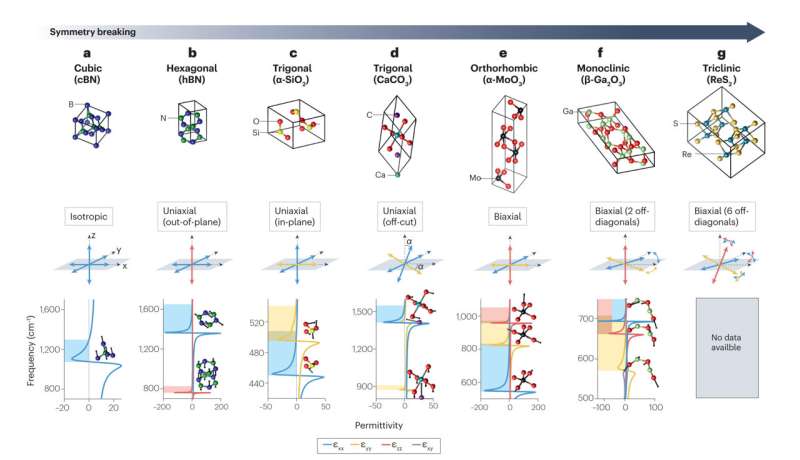
Structural and optical symmetry breaking in polar crystals. Credit: FHI
An international team of scientists provide an overview of the latest research on light-matter interactions. A team of scientists from the Fritz Haber Institute, the City University of New York, and the Universidad de Oviedo has published a comprehensive review article in Nature Reviews Materials. This article provides an overview of the latest research on polaritons, tiny particles that arise when light and material interact in a unique way.
In recent years, researchers worldwide have discovered that there are different types of polaritons. Some of them can trap light in a very small space, about the size of a nanometer. That’s about 80,000 times thinner than a human hair!
The scientists report in their article that these special polaritons can arise in certain crystals. When the light in these crystals generates special vibrations—the researchers call these “phonons”—these special polaritons are created. Interestingly, they also found that the less symmetric the crystal is, the better the whole thing works. This leads to new and exciting possibilities for controlling light in the smallest space.
In their article, the scientists provide an overview of the latest research findings and discuss how these new insights could be used in the future. They believe this work could help develop new materials that can use light innovatively.
Therefore, This fundamental research could have a major impact on many areas, from developing new technologies to improving existing devices.
More information:
Emanuele Galiffi et al, Extreme light confinement and control in low-symmetry phonon-polaritonic crystals, Nature Reviews Materials (2023). DOI: 10.1038/s41578-023-00620-7
Citation:
Light-matter interaction: Broken symmetry drives polaritons (2024, January 12)
retrieved 12 January 2024
from https://phys.org/news/2024-01-interaction-broken-symmetry-polaritons.html
This document is subject to copyright. Apart from any fair dealing for the purpose of private study or research, no
part may be reproduced without the written permission. The content is provided for information purposes only.
>>> Read full article>>>
Copyright for syndicated content belongs to the linked Source : Phys.org – https://phys.org/news/2024-01-interaction-broken-symmetry-polaritons.html































